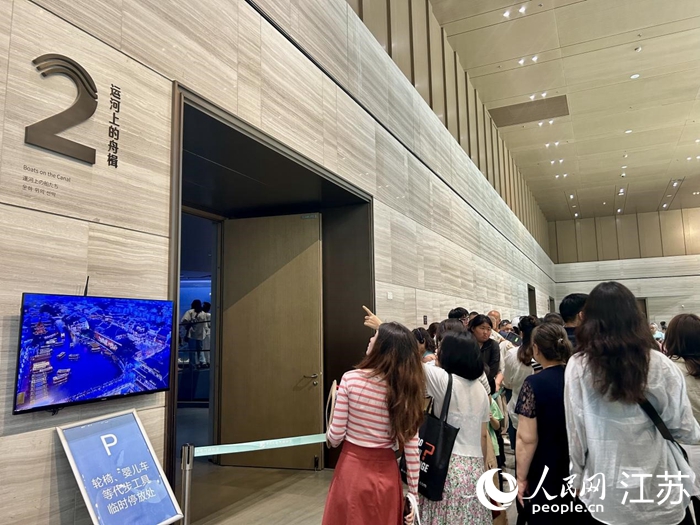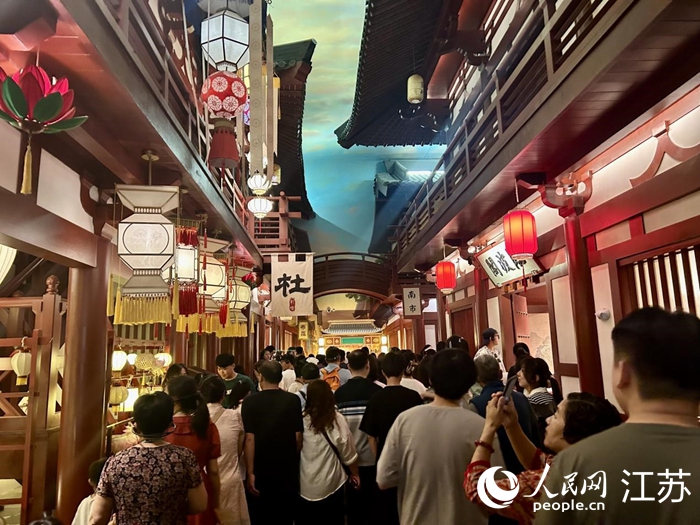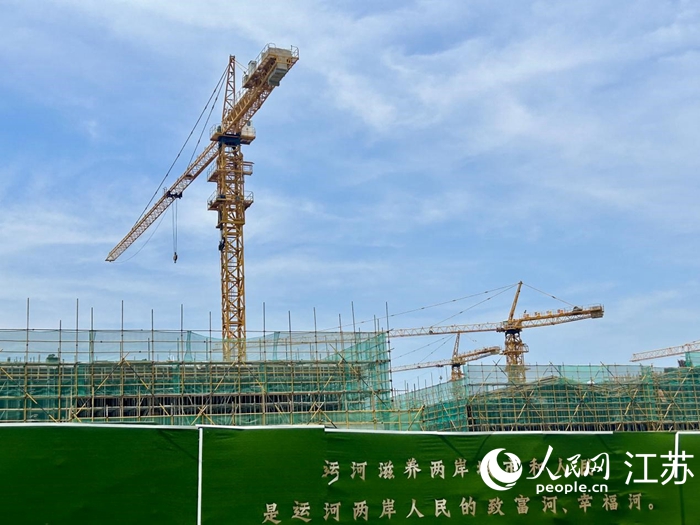China Grand Canal Museum fuels Yangzhou's transformation from industrial hub to cultural hotspot
The China Grand Canal Museum in Yangzhou, a city in east China's Jiangsu Province, was bustling with visitors as noon approached on June 18.
"Today's queue is manageable, but on weekends and holidays, the line often stretches from the ticket check to the main entrance, spanning tens of meters," said Sun Yuxia, a sanitation worker at the museum, which is located on the bank of the Sanwan section of the Grand Canal.

Tourists line up to enter the China Grand Canal Museum in Yangzhou, east China's Jiangsu Province. [People's Daily Online/Wang Dandan]
Yangzhou, a scenic city through which the Grand Canal runs, has recently planned nearly 100 projects to preserve cultural relics, with the Sanwan area, home to the museum, standing out as the most eye-catching.
However, the area was Yangzhou's largest industrial zone in the 1980s and 1990s, with over 80 factories producing pesticides, leather products, and cement lining both sides of the canal, leading to deteriorating water quality, silted waterways, and prominent environmental issues.
"There were no tourists then. Even locals wanted to move away as soon as possible," Sun recalled.
The Sanwan area's first "rebirth" came in early 2010 when local authorities designated its planning and development as a crucial initiative to improve southeast Yangzhou's ecological environment.
The first step was relocating 89 industrial enterprises, which were successively closed or moved. Additionally, 680 mu (45 hectares) of wetlands were restored. In September 2017, a brand-new Sanwan area was unveiled, transforming from an "urban scar" into a scenic ecological wetland.
But for Yangzhou, this was far from enough.

Photo shows crowds of tourists visiting the China Grand Canal Museum in Yangzhou, east China's Jiangsu Province. [People's Daily Online/Wang Dandan]
"The Grand Canal is of extraordinary significance to Yangzhou. Inheriting and utilizing the valuable cultural heritage bestowed by the Grand Canal is ingrained in our city's DNA," said Xu Guobing, an official with Yangzhou's cultural heritage administration.
"While protection is fundamental, Yangzhou is constantly exploring ways to pass on the Grand Canal's culture," he noted.
The listing of the Grand Canal as a UNESCO World Heritage Site marked a new era for the protection, inheritance, and utilization of its cultural heritage. The opening of the China Grand Canal Museum in the Sanwan area allowed the district to have its second "rebirth."
After two years of construction, the museum officially opened in June 2021, comprehensively showcasing the Grand Canal's profound heritage and appealing to the aesthetic sensibilities of residents and tourists alike. It has become a window for visitors to learn about the Grand Canal's cultural heritage.

The second phase of a China Grand Canal cultural park is under construction in Yangzhou, east China's Jiangsu Province. [People's Daily Online/Wang Dandan]
The museum, now a national first-class institution, has received over 8.3 million visitors.
As the "internet-famous museum" becomes Yangzhou's new tourism draw, officials are exploring how to transform foot traffic into economic growth.
The Sanwan area's third "rebirth" is underway, with a commercial district focused on cultural tourism consumption rapidly taking shape.
The ancient Sanwan section of the Grand Canal demonstrates Chinese wisdom in water control. Here, ancient Chinese engineers made three intentional turns to make the water safer. Today, the area showcases Yangzhou's transformation and the canal's revitalization.
The story of the canal benefiting the public continues, with the Grand Canal's cultural heritage expected to bring increasing happiness to Yangzhou's citizens.
























